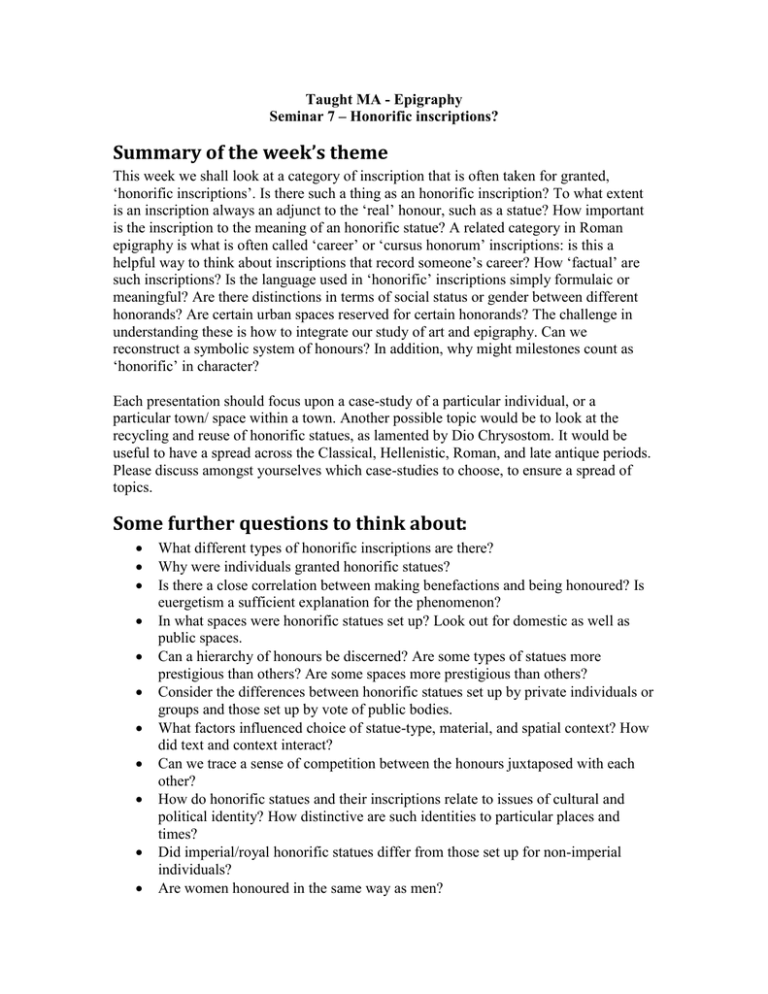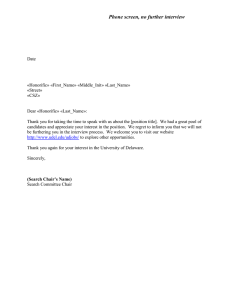Summary of the week’s theme
advertisement

Taught MA - Epigraphy Seminar 7 – Honorific inscriptions? Summary of the week’s theme This week we shall look at a category of inscription that is often taken for granted, ‘honorific inscriptions’. Is there such a thing as an honorific inscription? To what extent is an inscription always an adjunct to the ‘real’ honour, such as a statue? How important is the inscription to the meaning of an honorific statue? A related category in Roman epigraphy is what is often called ‘career’ or ‘cursus honorum’ inscriptions: is this a helpful way to think about inscriptions that record someone’s career? How ‘factual’ are such inscriptions? Is the language used in ‘honorific’ inscriptions simply formulaic or meaningful? Are there distinctions in terms of social status or gender between different honorands? Are certain urban spaces reserved for certain honorands? The challenge in understanding these is how to integrate our study of art and epigraphy. Can we reconstruct a symbolic system of honours? In addition, why might milestones count as ‘honorific’ in character? Each presentation should focus upon a case-study of a particular individual, or a particular town/ space within a town. Another possible topic would be to look at the recycling and reuse of honorific statues, as lamented by Dio Chrysostom. It would be useful to have a spread across the Classical, Hellenistic, Roman, and late antique periods. Please discuss amongst yourselves which case-studies to choose, to ensure a spread of topics. Some further questions to think about: What different types of honorific inscriptions are there? Why were individuals granted honorific statues? Is there a close correlation between making benefactions and being honoured? Is euergetism a sufficient explanation for the phenomenon? In what spaces were honorific statues set up? Look out for domestic as well as public spaces. Can a hierarchy of honours be discerned? Are some types of statues more prestigious than others? Are some spaces more prestigious than others? Consider the differences between honorific statues set up by private individuals or groups and those set up by vote of public bodies. What factors influenced choice of statue-type, material, and spatial context? How did text and context interact? Can we trace a sense of competition between the honours juxtaposed with each other? How do honorific statues and their inscriptions relate to issues of cultural and political identity? How distinctive are such identities to particular places and times? Did imperial/royal honorific statues differ from those set up for non-imperial individuals? Are women honoured in the same way as men? Suggested reading Bruun, C. & Edmondson, J. (2015) Oxford Handbook to Roman Epigraphy – chs by Beltrán Lloris; Hurlet; Bruun; Mouritsen; Schuler; Salway; Caldelli Cooley, A.E. (2012) Cambridge Manual of Latin Epigraphy Eck, W. (2009) ‘There are no cursus honorum inscriptions. The function of the cursus honorum in epigraphic comunication’ SCI 28: 79-92 http://terraitalia.altervista.org/servizi/articoli/Werner_no_iscriptions.pdf McLean, B.H. (2002) An Introduction to Greek Epigraphy of the Hellenistic and Roman Periods from Alexander the Great down to the Reign of Constantine 7.02, 9 Statues Dio Chrysostom Orations 31 Brilliant, R. (1963) Gesture and Rank in Roman Art: the use of gestures to denote status in Roman sculpture and coinage Gregory, A.P. (1994) ‘“Powerful images”: responses to portraits and the political uses of images in Rome’, JRA 7: 80-99 Hallett, C.H. (2005) The Roman Nude. Heroic Portrait Statuary 200 BC-AD 300 ch.4-7 Ma, John (2013) Statues and cities: honorific portraits and civic identity in the Hellenistic world Masseglia, J. (2015) Body language in Hellenistic art and society Newby, Z. and Leader-Newby, R., eds (2007) Art and Inscriptions in the Ancient World, ch 8 (*J. Ma ‘Hellenistic honorific statues and their inscirptions’); ch 9 (J. Shear ‘Reusing statues, rewriting inscriptions & bestowing honours in Roman Athens’) Nodelman, S. (1993) ‘How to read a Roman portrait’, in E. D’Ambra, ed. Roman Art in Context: An Anthology Oliver, A. (1996) ‘Honors to Romans: bronze portraits’, in C.C. Mattusch et al., eds The Fire of Hephaistos: Large Classical Bronzes from North American Collections 138-60 Scott, K. (1931) ‘The significance of statues in precious metals in emperor worship’, TAPhA 62: 101-23 Smith, R.R.R. (1988) Hellenistic Royal Portraits Stewart, A. (1979) Attika: Studies in Athenian Sculpture of the Hellenistic Age Stewart, P. (2003) Statues in Roman Society ch.3-5 Tanner, J.J. (2000) ‘Portraits, power, and patronage in the late Roman Republic’, JRS 90: 18-50 Welsh, M.K. (1904/5) ‘Honorary statues in ancient Greece’, ABSA 11: 33-49 Types of benefactor van Bremen, R. (1996) The Limits of Participation. Women & Civic Life in the Greek East in the Hellenistic and Roman periods ch.6 D’Arms, J.H. (1988) ‘Pompeii and Rome in the Augustan age and beyond: the eminence of the gens Holconia’, in R.I. Curtis, ed. Studia Pompeiana et Classica in Honor of Wilhelmina Jashemski vol.1 51-74 Eck, W. (1984) ‘Senatorial self-representation: developments in the Augustan period’ in F. Millar & E. Segal, eds Caesar Augustus. Seven Aspects 129-67 Forbis, E. (1990) ‘Women’s public image in Italian honorary inscriptions’, AJPhil 111: 493-512 Hemelrijk, E. (2015) Hidden lives, public personae: women and civic life in the Roman West Rose, C.B. (1997) ‘The imperial image in the eastern Mediterranean’, in S.E. Alcock, ed. The Early Roman Empire in the East 108-20 Identity van Nijf, O. (1999) ‘Athletics, festivals, and Greek identity in the Roman East’, PCPhS 56: 176-200 (2000) ‘Local heroes: athletics, festivals and elite self-fashioning in the Roman East’, in S. Goldhill, ed. Being Greek under Rome (2000) ‘Inscriptions and civic memory in the Roman East’, in A.E. Cooley, ed. The Afterlife of Inscriptions 21-36 Smith, R.R.R. (1981) ‘Greeks, foreigners, and Roman Republican Portraits’, JRS 71: 24378 (1998) ‘Cultural choice and political identity in honorific portrait statues in the Greek East in the second century AD’, JRS 88: 56-93 (1999) ‘Late antique portraits in a public context: honorific statuary at Aphrodisias in Caria, AD 300-600’, JRS 89: 155-89 Milestones CIL XVII for primary sources *Cooley, A.E. (2012) Cambridge manual of Latin epigraphy [to introduce the questions] Alföldy, G. (1991) ‘Augustus und die Inschriften: Tradition und Innovation. Die Geburt der imperialen Epigraphik’, Gymnasium 98: 289-324 Chastagnol, A. (1988) ‘Les inscriptions des monuments inaugurés lors des fêtes impériales’, MÉFRA 100.1: 13-26 Isaac, B. and I. Roll (1982) Roman Roads in Judaea I. The Legio-Scythopolis Road (BAR International Series 141: Oxford) Kolb, A. (2004) ‘Römische Meilensteine: Stand der Forschung und Probleme’, in Siedlung und Verkehr im römischen Reich, ed. R. Frei-Stolba (Peter Lang: Bern) 133-55 Salama, P. (1987) Bornes milliaires d’Afrique Proconsulaire. Un panorama historique du bas empire romain (CÉFR 101: Rome) Sillières, (. (1986) ‘De la borne milliaire à la dédicace impériale. L’exemple de quelques inscriptions routières de l’Hispanie Méridionale’, RÉA 88: 351-58 Witschel, C. (2002) ‘Meilensteine als historische Quelle? Das Beispiel Aquileia’, Chiron 32: 325-93



